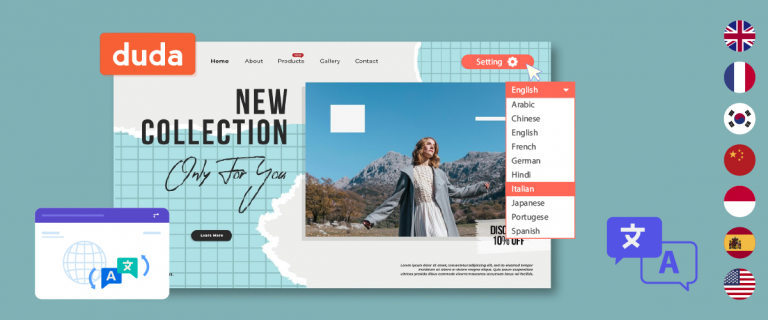Online shopping has increased quite significantly lately, and more and more businesses are now leveraging e-commerce as a solid revenue stream. In fact, recent forecasts have shown that retail e-commerce sales worldwide are expected to cross $8 trillion by 2026. Considering this, it can be stated that being in your online customers’ eyes is now more important than ever before.
Businesses can use search engine optimization (SEO) XML sitemaps to lead bots and crawlers to all their website pages. This, in turn, results in increased search engine ranking and allows businesses to increase their visibility. Translating sitemaps is equally important as it increases the number of pages indexed. Therefore, you must learn how to translate Yoast SEO XML Sitemaps and use them to your advantage.
What is an XML sitemap?
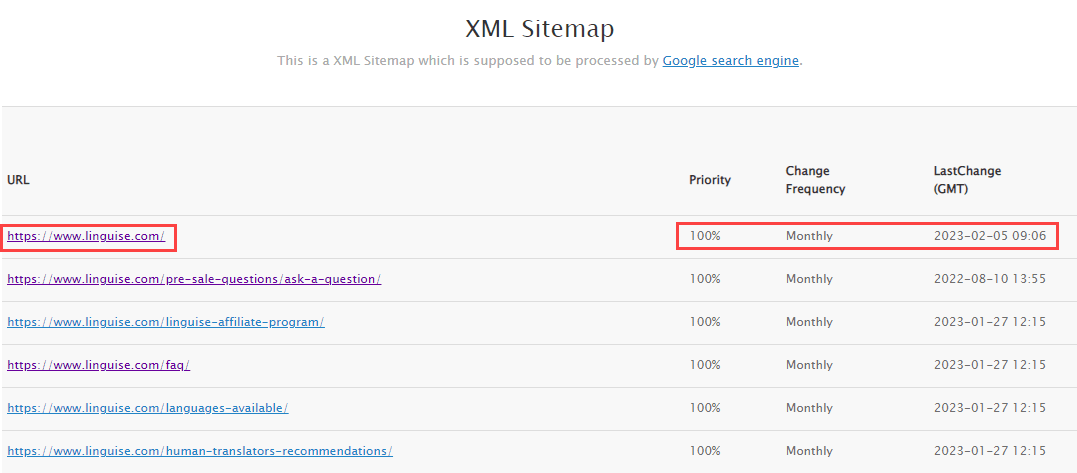
To keep it simple, an XML sitemap is basically a file that lists all the important pages of a website. Using an XML sitemap ensures that search engines like Google can find and crawl these pages and understand the structure of your website. So basically, it’s a standardized way of listing website pages and ensuring they can be discovered by search engines. An XML sitemap consists of multiple parts that include:
- XML version declaration – is used by search engine crawlers to determine the type of file they’re reading.
- URL set – provides protocol details to the search engine.
- URL – provides a list of the URLs of the web pages on a website.
- Lastmod – provides the most recent date on which the web page was modified.
When using XML sitemaps, it’s important to understand that it must follow this structure in order for it to be valid. A single XML sitemap can contain up to 50,000 URLs and can have a size of up to 50 MB. However, it’s important to mention that the number of URLs in a sitemap influences crawling speed.
The crawl speed is basically determined by the ratio of:
Your website traffic / The number of page you have. It means that if you have a website with small traffic, you don’t need to submit 50K URLs in your sitemap. Otherwise, your website maybe slowly indexed.
Difference between XML and HTML sitemaps
A HyperText Markup Language (HTML) sitemap is basically a written sitemap that serves as a directory for your website. Think of it like a table of contents for your website. It’s basically a list or an overview of all the pages on your website that an individual can visit. Search engines do not penalize websites for not having an HTML sitemap.
However, adding a sitemap to your website can drastically improve the user experience of your website. Visitors will be able to see all that you have to offer and can jump to any page they want with a single click! So with that in mind, it can be stated that the major difference between an XML and an HTML sitemap is that XML is for search engines and crawlers, and HTML is for actual visitors.
In addition, HTML sitemaps provide internal linking opportunities and improve website navigation. Whereas XML sitemaps provide faster page indexing and help avoid content duplication issues. One isn’t necessarily better than the others; therefore, you should use both sitemaps as they can help improve rankings and user experience.
Huge websites, just like Intel, use HTML sitemap:
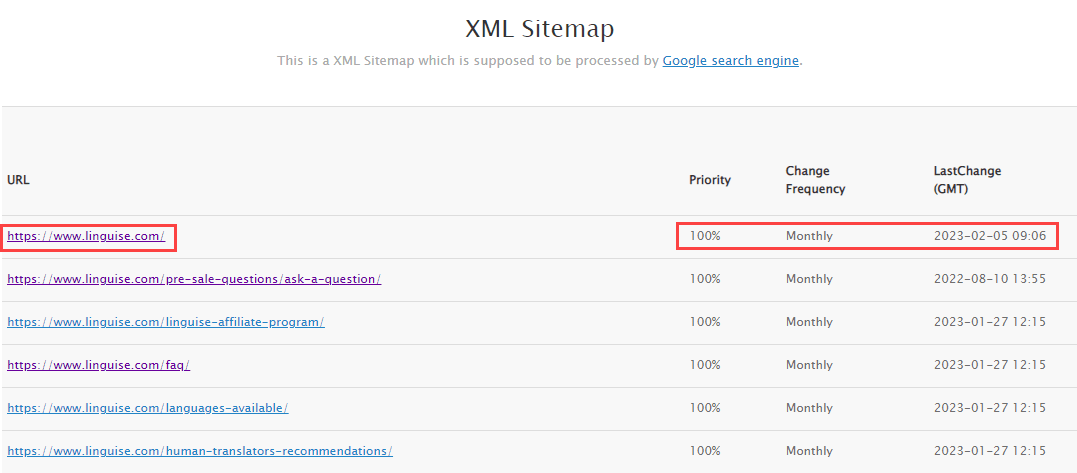
Importance of translated sitemaps for an international website’s SEO
Most people overlook the importance of translated sitemaps when optimizing their websites. Using translation sitemaps can help with SEO improvement and audience growth. International websites have multiple languages, and using sitemaps for such websites can improve indexing.
This means that if your website has around 10 languages and 50 pages, using multilingual sitemaps would result in 500 indexed pages! In addition, they help search engines better understand the structure and layout of your website. Furthermore, they can indirectly influence your website’s ranking resulting in more visibility.
Installing Yoast SEO plugin and activating the sitemap generation
The most effective way of translating a sitemap is to use a plugin. Plugins can be installed on your website’s content management system (CMS) and can be used to generate XML sitemaps. Using the Yoast SEO plugin remains the most preferred option for a number of reasons.
It assists search engine crawlers by prioritizing the most important pages of your website. In addition, it helps share meta elements allowing search engines to determine when your content was last updated. In addition, using Yoast allows you to control the information included in your sitemap.
How to install the Yoast SEO Plugin on your website
To install the Yoast SEO Plugin, log in to your website’s CMS. For this tutorial, we will be using WordPress as an example. Once you’ve logged in, click on “Plugins.”

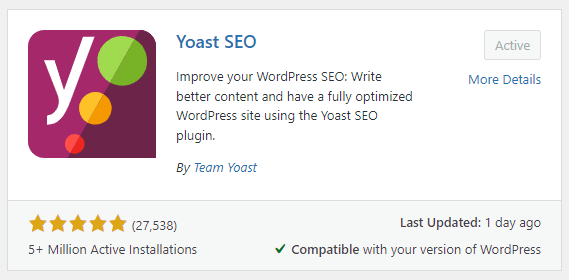
Activate The Plugin Settings and Visualize Your XML Sitemap




Translating the Yoast SEO sitemaps elements
WordPress multilingual plugins vs.Linguise
In addition to viewing the site maps, you need to add translated posts, pages, custom post types in your sitemap.
In some popular WordPress plugins like Polylang, that’s a manual action that is required. Usually, from the plugin configuration you can activate custom post types translations when it’s a proper custom post types. If that another type of content or specific taxonomies that will be just impossible to be done!
However, you can use Linguise automatic translation to skip over all the manual work, and it will automatically translate XML sitemaps for you. To do this, you’ll need to install the plugin in your website CMS.
To achieve this, begin by clicking on an XML sitemap file. For this example, we will use the “post-sitemap.xml” file.
Afterward, just add the language you want, like here it’s /fr/ for French translation. So in this example, we added “fr” in the URL to translate all the URLs within the “post-sitemap.xml” to French.
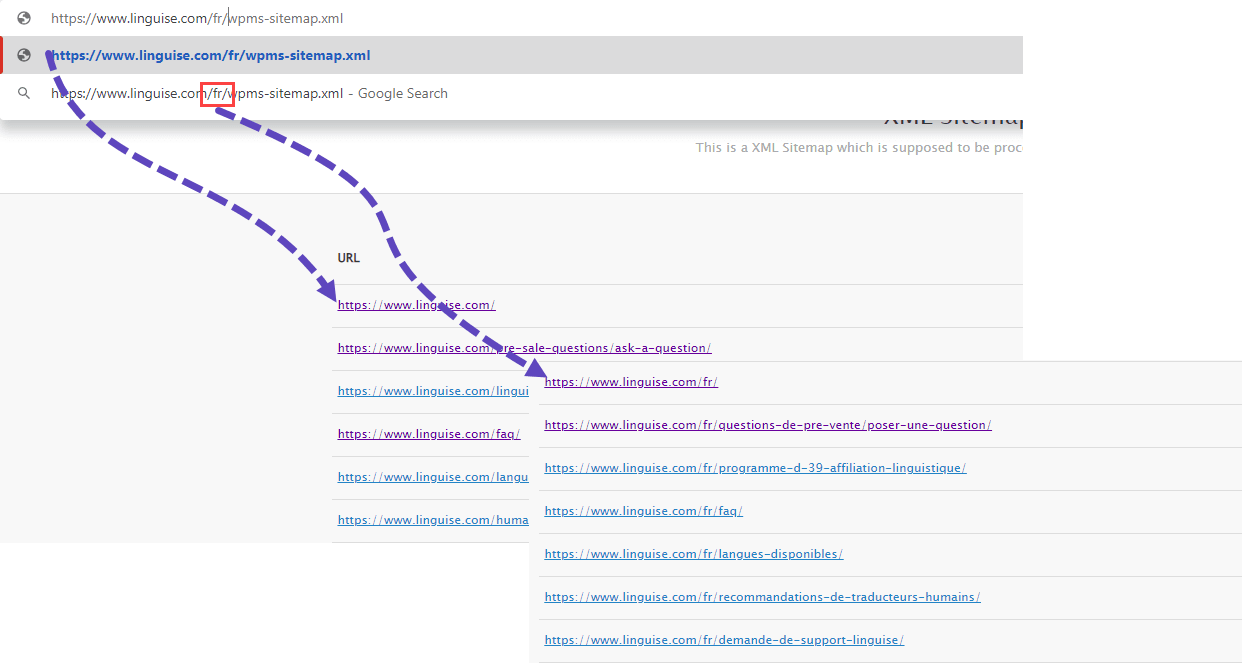
Linguise and XML sitemap translations
As Linguise is translated the WordPress website URLs directly and not by content types, it makes the thing easier to include 100% of your content in translated sitemaps.
Let’s verifying that on the Linguise dashboard where you can also check the URLs.
Once access the Linguise admin dashboard for your website, click on the “Translations” option from the top menu.


Here you can see all the URL translations Linguise has done. As Linguise generates automatically all the URLs, you’ll be able to automatically generate a multilingual sitemap!

To check that, you can view your website in any browser and see the automatic URL translating in real time. Simply visit your website. In this example, you can see that the URL below is currently in English.
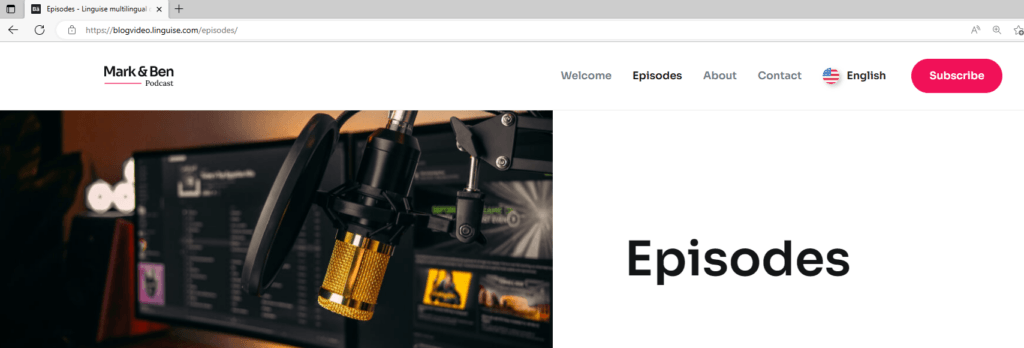
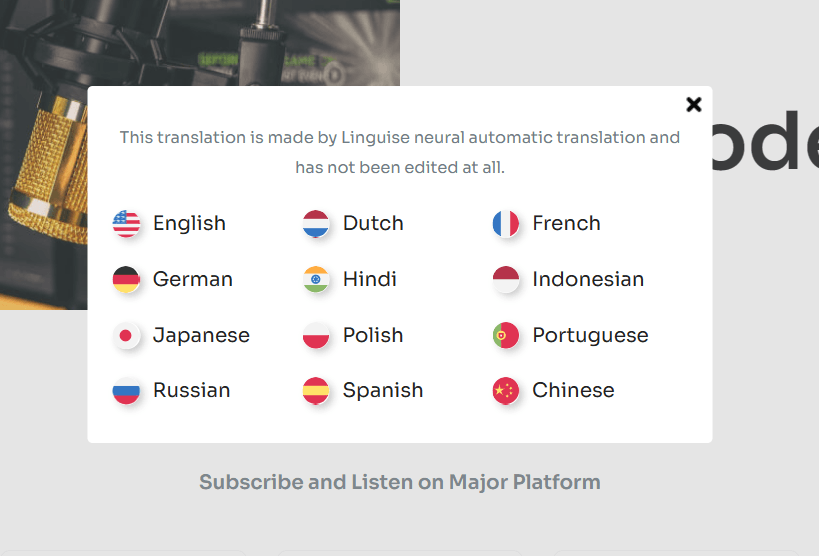

Finalizing the XML sitemap translation
In order to gain the full benefits of the translated XML sitemaps, you must submit them to the search engine. However, prior to submitting these URLs, you must review and finalize the sitemaps. The Yoast SEO plug can be used to create translated sitemaps for your entire website. In addition, it can also be integrated with other extensions, such as WooCommerce.
Using the Yoast SEO plugin in combination with the WooCommerce extension will allow you to ensure a complete sitemap translation. This includes URLs for your WooCommerce store’s main, category, product, and even add-to-cart pages. For this example, we will translate sitemaps for all the pages within the “product-sitemaps.xml” file.

Submitting The XML Sitemaps
When you have viewed all the translations of your sitemaps, you can then begin to submit them to search engines. Two of the most popular search engines worldwide include Google and Bing. To submit your translated sitemaps to either of these search engines, you will be required to log in to the admin console and access the sitemap settings.
After gaining access, you must add or replace the XML sitemaps with the translated version. Please note that the search engine console will provide you with an indication of whether the sitemap XML file was read or not. You can also check back after a week to see if the search engine has successfully indexed translated URLs and pages.
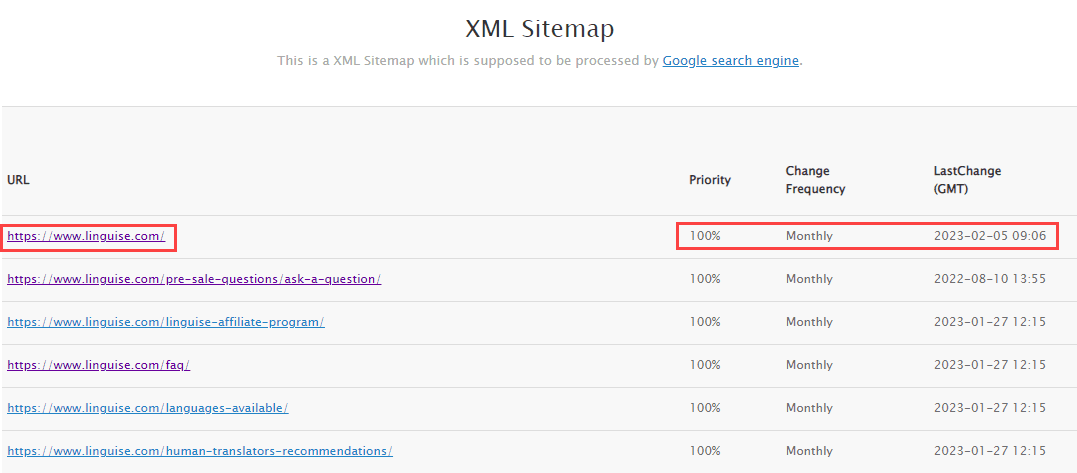
Key takeaways on XML sitemap translation
Investing some time in preparing the XML sitemaps with Yoast then using an automatic translation tool Linguise to generate a multilingual version, will bring you big SEO improvement.
It allows you to create translated sitemaps resulting in more URLs being indexed and the possibility of a higher ranking as your website is growing. Start now and see the benefits of the Linguise automatic translation service.



